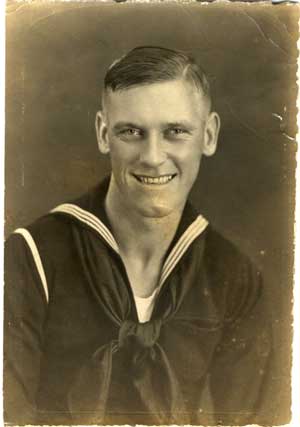MY MOTHER WAS VERY PROUD OF HER BROTHER GEORGE.
And she had good reason!
Her younger brother, George, enlisted in the Navy when he was 18 in 1930.
He visited us occasionally when I was growing up and my mother was always excited to see him.
I remember that he talked only when urged about his close brush with death on the coast of Newfoundland.
He made light of it. He told me that when he finally made it to the narrow stony beach beneath the cliffs that seemed so high as cold and wet and exhausted by his own efforts to get to shore.
And so he began doing jumping-jacks to keep his muscles going and to get his blood to circulate freely.. Later someone from the town who helped him told him that when they saw George doing his jumping jacks and ordering other sailors who had made it to the shore to join him, they said "That guy wants to live,"
And the towns people came down the cliff face and helped men to leave that freezing shoreline. George helped them to aid the other men. Then he took his turn and was helped up to the top of the cliff.
He was taken to hospital and there he got well again,
So much gratitude-- he expressed to the wonderful people of Newfoundland who rescued him and his ship mates.
 George L. Coleman was born at Valley Falls, Rhode Island on April 4, 1912 to parents Jane and Joseph Coleman. He enlisted in the US Navy in 1930 and initially served in the eastern Pacific Ocean aboard the armored cruiser USS Seattle. He transferred to the Navy's Asiatic Fleet several years later, where he served for three years aboard the heavy cruiser USS Augusta. Coleman was reassigned in 1941 to the supply ship USS Pollux, which transported troops, equipment, food, and other goods to Allied ports on both sides of the North Atlantic. He was 29 years old when the vessel ran aground off Newfoundland's south coast during a violent winter storm on February 18, 1942.
George L. Coleman was born at Valley Falls, Rhode Island on April 4, 1912 to parents Jane and Joseph Coleman. He enlisted in the US Navy in 1930 and initially served in the eastern Pacific Ocean aboard the armored cruiser USS Seattle. He transferred to the Navy's Asiatic Fleet several years later, where he served for three years aboard the heavy cruiser USS Augusta. Coleman was reassigned in 1941 to the supply ship USS Pollux, which transported troops, equipment, food, and other goods to Allied ports on both sides of the North Atlantic. He was 29 years old when the vessel ran aground off Newfoundland's south coast during a violent winter storm on February 18, 1942.
Coleman survived the shipwreck, but 93 of his fellow sailors drowned or froze to death; among the dead was his close friend George Marks. Years later, Coleman described to author Cassie Brown how he felt while watching men jump overboard: "I believe I was more stunned and bewildered to see what was happening and just couldn't believe what was going on. I don't know how long I was standing there by the lifeline looking down in that raging sea when I raised my eyes and looked towards the beach and I saw one sailor making his way to the beach, and then he may have been about 12 to 15 feet from the beach. I saw him turn around, face the ship, give a hand salute, and I saw him go down."
Coleman eventually made it to shore and was rescued by a group of men from the nearby communities of Lawn and St. Lawrence. He spent three weeks in hospital following the disaster and returned to military service shortly afterwards. He participated in the invasion of North Africa during the Second World War and also fought in France, Normandy, England, and Norway before peace was restored in 1945.
Coleman was married to Helen for 25 years before she died of cancer in the 1960s. The two did not have any children. Coleman remarried in 1966, this time to Marcellena Lawson, and the pair lived in Norfolk, Virginia.
What a wonderful story of your Uncle George. I love the way he now lives in all of us who read your story and will thing of his jumping jacks and how he returned to the military after 3 weeks in the hospital.
ReplyDelete